Scotch Macaskill's Wildlife Blog
IMPORTANT: Please note that from April 2009 this Blog's Web address changed as a result of a switch in the blogging platform we use. It's still an integral part of the Wildlife Pictures Online website and, we hope, will continue providing entertaining and enjoyable content in the form of wildlife images, news, views and information.
For the most recent posts, links, and other resources, please visit the new Wldlife Photography Blog.
|
Today's Picture: African Elephant, front-on view
March 4, 2007
|
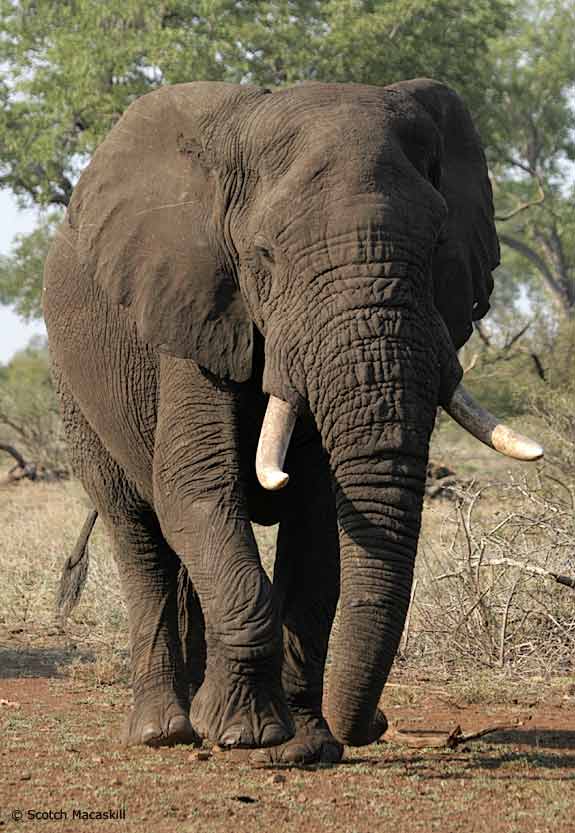
Photo Details: Elephant (Loxodonta africana) walking towards waterhole, Kruger National Park, South Africa.
Camera: Canon EOS 400D; Lens: Canon 100-400 IS Zoom; Focal Length: 170mm; Shutter speed: 1/320; Aperture: f5.6; ISO: 200.
Additional Info: The photograph was taken in December last year while staying at Satara Camp in the Kruger National Park. It was mid-summer and very hot and, as this was our first day in the park after a long day on the road, we didn't go for the usual afternoon game drive.
Around 4pm - still harsh sunlight and very hot - a large elephant (presumably a bull from its size) came strolling into view. Our accommodation was next to the camp fence, overlooking a small waterhole, and it was to this water that the ele was heading.
It's not often one has the opportunity to stand relatively close to elephants, yet feel safe, which the fence in this case allowed. It was also a good chance to get some photographs, but the square gaps in the mesh fence were not nearly large enough to poke a big lens through.
Instead, I simply held the lens agains the fence, lining it up with the hole as best I could. Certainly through the viewfinder I couldn't see any wires, so I snapped away. On downloading the images, I was pleasantly surprised. Even at full size in Photoshop, I could not see any trace of the fence wire.
Although I was shooting at the widest aperture available - f5.6 on the 100-400 zoom - I thought it might not be wide enough to throw any intruding wires so out of focus that they totally disappeared, but that appears to have happened. The fact that the camera has a sensor that's smaller than a 35mm frame may also have something to do with this, but I can't see why - then I'm not very technically minded.
So it's worth remembering - when next you see something interesting through a fence, don't ignore the opportunity and rather try simply taking pictures through the chinks.
|
Today's picture: Lion Fangs
March 13, 2007
|
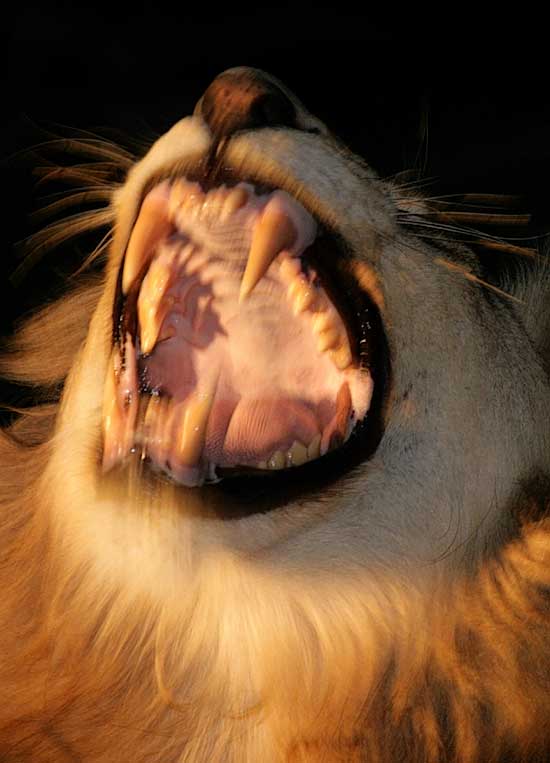
Photo Details: Male Lion (Panthera leo) shows his formidable fangs, Elephant Plains Game Reserve,
Sabi Sands, South Africa.
Camera: Canon EOS 400D; Lens: Canon 100-400 F5.6 IS zoom; Focal Length: 400mm; Shutter Speed: 1/30; Aperture: f5.6; ISO: 800; Lighting: Spotlight plus fill-in flash.
Additional Info: The picture was taken after nightfall on an evening game drive. The lion was illuminated by a hand-held spotlight, hence the need to shoot at a slow shutter speed (1/30th) with ISO set to 800. That's the penalty of using a lens with a maximum aperture of F5.6.
For this shot I added some fill-in flash which, combined with camera and subject movement, has created interesting streaks and blur, giving the image an impressionistic feel (or maybe just leaving it looking fuzzy - depends on your taste!).
|
Today's picture: Baby Fangs
March 18, 2007
|
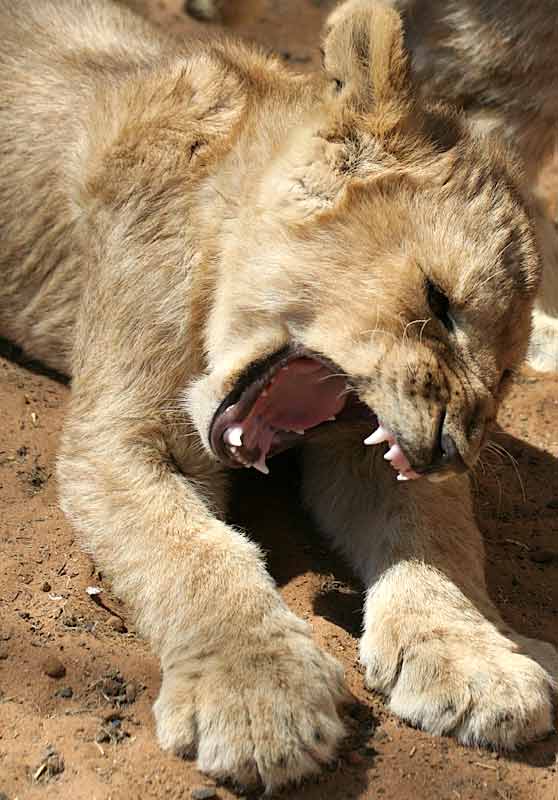
Photo Details: Lion cub (Panthera leo) reveals its already impressive canines while having a big yawn, Sondéla Wildlife Centre, Limpopo Province, South Africa.
Camera: Canon EOS 350D; Lens: Canon 100-400 IS Zoom; Focal Length: 100mm; Shutter speed: 1/2500; Aperture: f5; ISO: 400
Additional Info:The lion cub was one of a litter of four being cared for at Sondéla Wildlife Centre, an animal hospital, prior to being released back into the wild. Although it was only around two months old when the photo was taken, the cub's prominent canines, together with its massive paws, hint at what lies ahead for the hapless animals that one day will fall prey to an adult lion's hunting skills.
|
Wildlife Photos Available on "Virtual CD"
March 19, 2007
|
Wildlife stock photos are now available at a very affordable price on "virtual CDs", making them immediately available - you simply order and download.
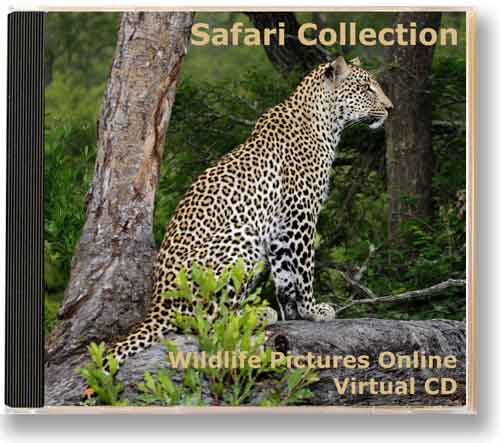
There are three CDs available, each containing 50 wildlife pictures:
1. Safari Collection - this offers the largest variety of images and is ideal for anyone needing a good cross-section of wildlife typically viewed on an African safari.
2. Giants of the Bush - features images of Africa's largest and most impressive land mammals - elephant, buffalo, giraffe, hippo, and rhino.
3. Big Cats - compelling photos of Africa's magnificent big cats - lion, leopard and cheetah.
All the photographs are from 1200 to 1500 pixels on their long side, so will give good prints up to 8" x 10" from a photo lab, or they can be printed letter (A4) size from a home printer for reference work and educational projects.
You can find out more about the Virtual CDs from here.
|
Today's picture: African Python
March 21, 2007
|
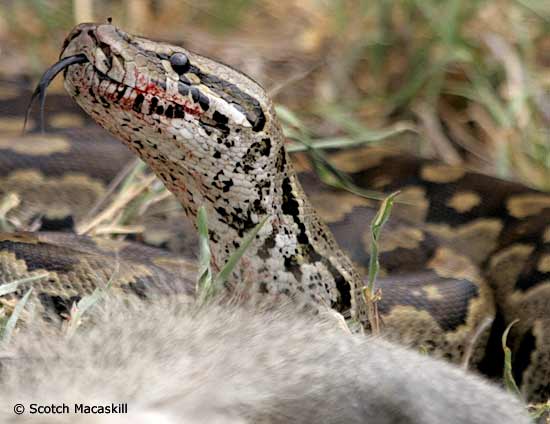
Photo Details: Close up of African Rock Python (Python sebae) showing its bloodied face after it caught and killed a male vervet monkey (foreground), Kruger National Park, South Africa.
Camera: Canon EOS 400D; Lens: Canon 100-400 F5.6 IS zoom; Focal Length: 285mm; Shutter Speed: 1/400; Aperture: f5.6; ISO: 400.
Additional Info: The above photo is one of a series taken while we watched the python with its victim, a large male vervet monkey. To read the article and view additional python pictures, please see
Python Nabs Vervet Monkey.
Did You Know: Pythons are ambush predators, typically staying camouflaged before suddenly striking at passing prey. They then grasp the victim in their teeth while coiling their body round the prey, before killing by constriction. Death is usually a result of suffocation or heart failure rather than crushing.
Big African pythons can kill fairly large animals such as antelopes (see
previous blog picture), pigs, jackals and monkeys, but will not usually attack humans unless startled or provoked.
Please Note: Pictures displayed on this blog are copyright protected. View them online, enjoy them, but kindly do not use them for anything else. Should you wish to purchase an image or require clarification on use, please contact me.
|
| |
| Back to top of page
|
|
Previous Entries
By Month
By Category
My Original Blog
2005 Entries
2004 Entries
2003 Entries
Who Am I?
Brief Bio
|





